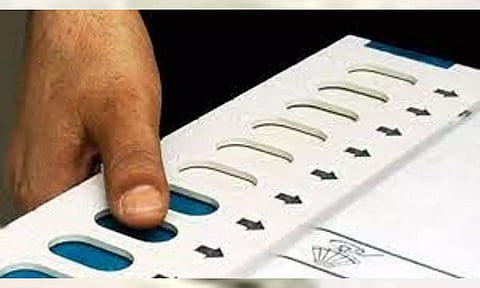

NEW DELHI: Last week, the Supreme Court rejected pleas for reviving paper ballots and 100 per cent cross-verification of votes cast on Electronic Voting Machines (EVMs) with a Voter Verifiable Paper Audit Trail (VVPAT), holding that suspicions regarding tampering of the voting machines were “unfounded”. The development transpired amidst the country voting in round two of the seven-phase 2024 Lok Sabha elections. A bench of the top court argued that the plea for return to the ballot paper system was unsound, noting that the weakness of this system was well known and documented — vis-a-vis booth capturing and bogus voting.
The petitions before the Supreme Court sought that VVPAT slips should be given to the voter to be verified, and then inserted in the ballot box for counting, a plea that was rejected. It might be recalled that EVMs were first used in 1982 in the assembly constituency of Paravur in Kerala in 50 out of 123 booths. Since then, over 118 crore electors have cast their votes using EVMs.
In the 2019 general elections, as many as 61.4 crore people cast their votes via 23.3 lakh ballot units; 16.35 lakh control units and 17.40 lakh VVPAT units were employed in the previous elections. This year, 97 crore people are registered to vote; 21.60 lakh ballot units, 16.80 lakh control units and 17.7 lakh VVPAT units will be employed. Combine that data with the number of candidates contesting the election, the number of polling booths where voting is held, and the issues faced with ballot papers, and you get an inkling of how India’s electoral exercise needs to rely on EVMs.
But, the system is not foolproof. Last week, the Election Commission of India (ECI) said it had resolved the issue of some EVMs showing an extra vote during a mock poll in the north Kerala district of Kasaragod. The Returning Officer (RO) of Kasaragod Lok Sabha constituency in his letter to the Chief Electoral Officer of Kerala said at the time of ‘self checking’, four EVMs printed out an additional slip other than the usual slips. Apart from this, in a few other districts of the state, breakdowns of EVMs were reported in some booths.
A few technical issues have also been raised by the petitioners — the Association for Democratic Reforms. Some of these are in response to ECI’s claim that the EVMs cannot be hacked; that the EVM microprocessors are only One Time Programmable (OTP), so no new program can be loaded in those. Experts have questioned ECI’s logic of not introducing the electronic pairing process for the control unit and VVPAT, which raises doubts on the potential for tampering. The apex court’s claim that the burnt or uploaded memory of the microcontrollers of 5% of EVMs can be checked by the EVM manufacturers also raises the question of a conflict of interest.
It seems counter-intuitive to the democratic process that in the absence of empirical data pertaining to the level of trust citizens associate with EVMs, the Supreme Court has gone ahead and given a clean chit to the system. Unless data pertaining to the actual flow of information between the EVMs, the control unit and the VVPATs are verified transparently, this shadow of doubt regarding its efficacy will linger on the minds of the electorate.